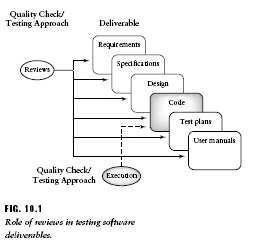Chapter: Software Testing : Controlling and Monitoring
Review program
Review program
A review is a group meeting whose purpose is to
evaluate a software artifact or a set of software artifacts.
The
general goals for the reviewers are to:
• identify
problem components or components in the software artifact that need
improvement;
• identify
components of the software artifact that do not need improvement;
• identify
specific errors or defects in the software artifact (defect detection);
• ensure
that the artifact conforms to organizational standards.

Other
review goals are informational, communicational, and educational, whereby
review participants learn about the contents of the developing software
artifacts to help them understand the role of their own work and to plan for
future stages of development. Reviews often represent project milestones and
support the establishment of a baseline for a software artifact. Thus, they
also have a role in project management, project monitoring, and control. Review
data can also have an influence on test planning. The types and quantity of
defects found during review can help test planners select effective classes of
tests, and may also have an influence testing goals. In some cases
clients/users attend the review meetings and give feedback to the development
team, so reviews are also a means for client communication. To summarize, the
many benefits of a review program are:
• higher-quality
software;
• increased
productivity (shorter rework time);
• closer
adherence to project schedules (improved process control);
• increased
awareness of quality issues; teaching tool for junior staff;
• opportunity
to identify reusable software artifacts;
• reduced
maintenance costs;
• higher
customer satisfaction;
• more
effective test planning;
• a more
professional attitude on the part of the development staff.
Not all
test educators, practitioners, and researchers consider technical reviews to be
a testing activity. Some prefer to consider them in a special category called
verification testing; others believe they should be associated with software
quality assurance activities. The author, as well as many others, for example,
Hetzel [2], hold the position that testing activities should cover both
validation and verification, and include both static and dynamic analyses. The
TMM structure supports this view. If one adheres to this broader view of
testing, then the author argues the following:
(i) Reviews
as a verification and static analysis technique should be considered a testing
activity.
(ii) Testers
should be involved in review activities.
Also, if
you consider the following:
(i) a
software system is more than the code; it is a set of related artifacts;
(ii) these
artifacts may contain defects or problem areas that should be reworked, or
removed;
and
(iii)quality-related
attributes of these artifacts should be evaluated;
then the
technical review is one of the most important tools we can use to accomplish
these goals. In addition, reviews are the means for testing these artifacts
early in the software life cycle. It gives us an early focus on quality issues,
helps us to build quality into the system from the beginning, and, allows us to
detect and eliminate errors/defects early
in the software life cycle as close as possible to their point of origin. If we
detect defects early in the life cycle, then:
• they are
easier to detect;
• they are
less costly to repair;
• overall
rework time is reduced;
• productivity
is improved;
• they have
less impact on the customer.
Use of
the review as a tool for increasing software quality and developer productivity
began in the 1970s. Fagen and Myers wrote pioneering papers that described the
review process and its benefits. This chapter will discuss two types of
technical reviews, inspections, and walkthroughs.
It will
show you how they are run, who should attend, what the typical activities and
outputs are, and what are the benefits. Having a review program requires a
commitment of organizational time and resources. It is the author‘s goal to
convince you of the benefits of reviews, their important role in the testing
process, their cost effectiveness as a quality tool, and why you as a tester
should be involved in the review process.
Related Topics